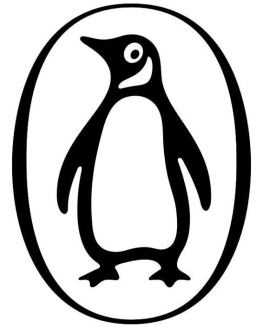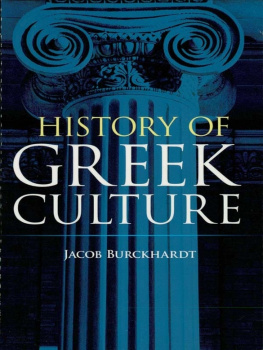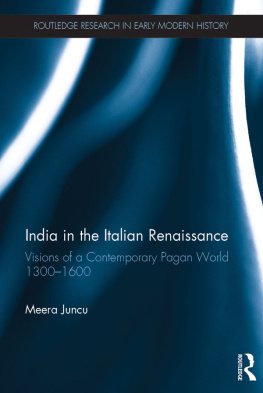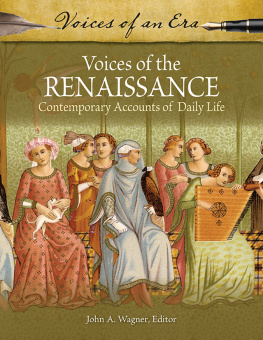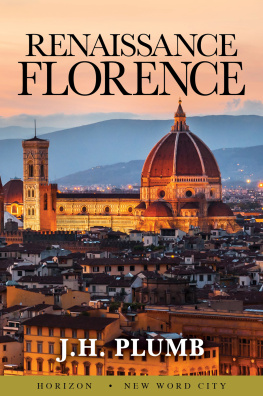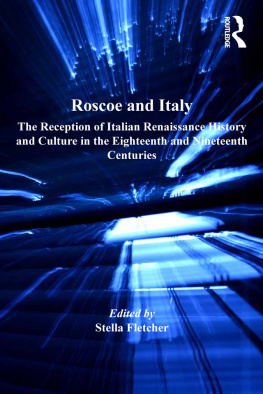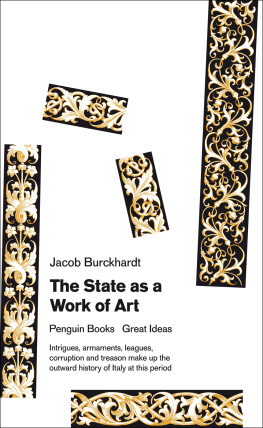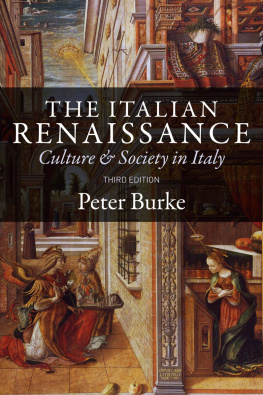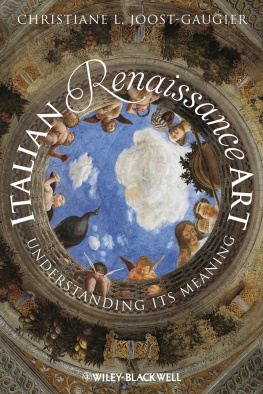

THE CIVILIZATION OF THE RENAISSANCE IN ITALY
J ACOB B URCKHARDT was born in Basel in 1818. He intended to join the Church and studied theology before losing his faith. Between 1839 and 1842 he studied at the University of Berlin, devoting himself to history, and attended seminars given by Leopold von Ranke, the most famous living historian of the time. Burckhardt took his doctorate in 1843 and lectured at the University of Basel. In 1853 he published The Age of Constantine the Great , which was followed two years later by a historical guide to the art treasures of Italy, The Cicerone . These two books won Burckhardt a chair, and in 1855 he became Professor of Architecture and History at the Zurich Polytechnic. While there he wrote The Civilization of the Renaissance in Italy . Returning to Basel in 1858, he remained there for the rest of his life, lecturing at the university; in his own words, he lived exclusively for [his] work as a teacher. He published little, apart from The Architecture of the Renaissance in Italy (1867). After his death in 1897 his remaining works, mainly lecture notes, were published. Rubens, Essays on the History of Art in Italy and Cultural History of Greece appeared in 1898, followed by the Reflections on World History (1905) and the Historical Fragments (1929).
P ETER B URKE is Reader in Cultural History, University of Cambridge, Fellow of Emmanuel College, Cambridge, and author of The Italian Renaissance, Popular Culture in Early Modern Europe and History and Social Theory .
From 1980 until his death in 1992, Peter Murray was Emeritus Professor of the History of Art at the University of London. He taught at the Courtauld Institute from 1949 to 1967 and served there as the first Witt Librarian, until he succeeded Sir Nikolaus Pevsner in the chair of Art History at Birkbeck College. He was President of the Society of Architectural Historians of Great Britain and Chairman of the Society of Renaissance Studies. He published an annotated edition of Burckhardts Architecture of the Italian Renaissance in 1985 (Penguin 1987) and his own books include The Architecture of the Italian Renaissance (third edition, 1986) and Renaissance Architecture , as well as The Penguin Dictionary of Art and Artists with his wife Linda (the sixth edition of which was published in 1989), with whom he also wrote The Art of the Renaissance , first published in 1963.
JACOB BURCKHARDT
THE CIVILIZATION OF THE RENAISSANCE IN ITALY
Translated by S. G. C. Middlemore
With a new Introduction by Peter Burke
and Notes by Peter Murray
PENGUIN BOOKS
PENGUIN BOOKS
Published by the Penguin Group
Penguin Books Ltd, 80 Strand, London WC2R 0RL , England
Penguin Putnam Inc., 375 Hudson Street, New York, New York 10014, USA
Penguin Books Australia Ltd, 250 Camberwell Road, Camberwell, Victoria 3124, Australia
Penguin Books Canada Ltd, 10 Alcorn Avenue, Toronto, Ontario, Canada M4V 3B2
Penguin Books India (P) Ltd, 11 Community Centre, Panchsheel Park, New Delhi 110 017, India
Penguin Books (NZ) Ltd, Cnr Rosedale and Airborne Roads, Albany, Auckland, New Zealand
Penguin Books (South Africa) (Pty) Ltd, 24 Sturdee Avenue, Rosebank 2196, South Africa
Penguin Books Ltd, Registered Offices: 80 Strand, London WC2R 0RL , England
www.penguin.com
This edition first published 1990
Introduction copyright Peter Burke, 1990
Notes copyright Peter Murray, 1990
All rights reserved
Except in the United States of America, this book is sold subject
to the condition that it shall not, by way of trade or otherwise, be lent,
re-sold, hired out, or otherwise circulated without the publishers
prior consent in any form of binding or cover other than that in
which it is published and without a similar condition including this
condition being imposed on the subsequent purchaser
EISBN: 9781101491492
CONTENTS
Introduction
JACOB BURCKHARDT AND THE ITALIAN RENAISSANCE
Jacob Burckhardt was not only one of the greatest historians of the nineteenth century; he remains one of the most accessible to modern readers. Born in 1818, the same year as Karl Marx, Burckhardt belonged to one of the best-known Basel families; monuments to seventeenth-century Burckhardts can still be seen in the cathedral there. Jacob Burckhardt senior was a clergyman of scholarly interests, who collected coins and medals and wrote on local history, and at the age of seventeen Jacob junior followed in his fathers footsteps and carried out research on behalf of a German professor who was writing a book on the Swiss humanist Glareanus. Burckhardt was intended for the Church and studied theology, at his fathers suggestion, before losing his faith and deciding to be a scholar. Between 1839 and 1842 he studied at the university of Berlin. He followed courses on ancient history, the history of architecture, and Arabic. He also attended the seminars of the most famous living historian of the time, Leopold von Ranke, and wrote a paper for him on an early medieval topic, the achievement of Charles Martell.
Burckhardt disliked Ranke as a person but admired him as a historian. He considered publishing the paper on Charles Martell and becoming a medievalist, but decided against both. His visits to Italy, from 1837 onwards, and his friendship with one of the younger professors, Franz Kugler, had fired him with enthusiasm for cultural history and for the classical and Renaissance world. He returned to Basel in 1843, took his doctorate, and began to lecture in the university on a wide range of topics, including the history of painting, the Middle Ages, the Counter-Reformation in Switzerland, and the Roman emperors. At first he combined his academic duties with the task of editing a conservative paper, the Basler Zeitung , for four or five hours a day.
However, he came to feel an increasing dislike for politics, and also for the degrading mtier of journalist, and in 1846, when his friend Kugler asked for help in preparing a second edition of his successful Handbook of Art History , Burckhardt gave up the newspaper in order to spend more time on his research. The first-fruits of this research were a major book on The Age of Constantine the Great , published in 1853, when the author was 35, followed two years later by an extremely successful historical guide to the art treasures of Italy, The Cicerone .
These two books won Burckhardt a chair. He was called to the Zurich Polytechnic when it opened its doors in 1855, to be the professor of architecture and art history. He lectured on the Renaissance, and it was here that he wrote his most famous work, The Civilization of the Renaissance in Italy . However, he returned to Basel as soon as he could, in 1858, and remained there for the rest of his life. From this time onwards Burckhardt lived exclusively for his work as a teacher, as he put it himself, lecturing to a handful of students during the week and to the general public on Saturdays on history and art history, and refusing the flattering invitation to succeed Ranke in Berlin.
Burckhardt published little after 1860, apart from The Architecture of the Renaissance in Italy (1867), a relatively technical study presented more or less in note form (but attentive all the same to the social and political context of building). It was only after his death, in 1897, that his remaining studies, for the most part notes for his lectures, appeared in print. His Rubens, Essays on the History of Art in Italy and Cultural History of Greece all appeared in 1898, followed by Reflections on World History (1905) and Judgements on History and Historians (1929).
Next page
